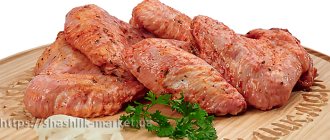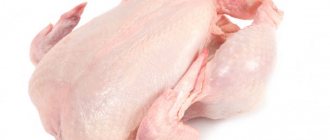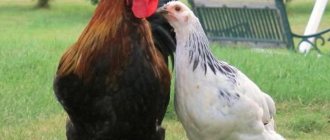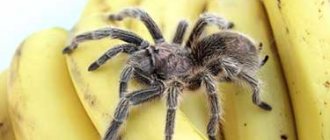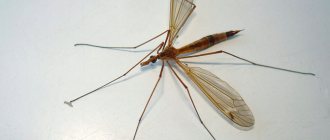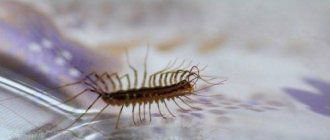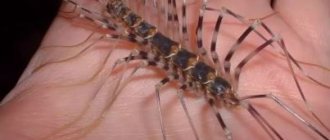Have you ever seen green meat in broilers? This is a very unpleasant sight...
Green meat in broiler chickens is the result of pathology. This phenomenon was first described by Americans who were raising chicken in Oregon.
Below are the details and causes of the origin of this disease.
Green muscle disease is associated with a rapid increase in the weight of the bird and a simultaneous lag in the development of connective tissues in the thoracic region
Russian scientists believe that the pathology is caused by ischemia of the pectoral muscles, which occurs due to insufficient blood supply, leading to a lack of oxygen, vitamins, and minerals in the tissues. In severe forms of the pathology, dystrophy, atrophy, and necrosis are observed.
Is green chicken meat dangerous?
All modern factories pursue one single goal - maximum weight gain of poultry in the shortest possible time. Selection opportunities have caused the so-called hypertrophy, which affects the pectoral muscles of the broiler. This disease generally affects other muscle groups and bones. Muscle hypertrophy significantly limits the bird's mobility.
“Oregon disease” is often accompanied by limb weakness, cellulite, and white muscle pathology. The latter occurs due to a lack of selenium in the diet, metabolic disorders in cells
Why do broilers have green meat? Large-scale necrosis gives the meat this color. This pathology mainly affects broiler turkeys.
The following pathologies were also observed: pallor and swelling of the deep muscles of the sternum, thinning of the fascia, necrotic changes in the areas of edema.
Most often, green breasts are observed in males, due to greater muscle mass than in females. If such poultry meat ends up in catering establishments or stores, it is discarded.
The broiler has green meat in its breast
White stripes on the meat. The defect may vary in size of the visible streaks from less than 1 mm to over 2 mm in width. The prevalence of this defect in some herds can exceed 12 percent, and the defect is visible on the fillet (pectoralis major muscle). The prevalence of “white markings” directly correlates with high weight for age and is typical for broilers weighing over 3.5 kg. On microscopic examination, the affected muscles show deposits of adipose tissue, displacing damaged muscle fibers, resulting in characteristic visible changes. Unlike normal tissue, its moisture content is slightly lower and protein levels are significantly reduced, but these losses are compensated by higher levels of fat and collagen, which are deposited to the detriment of muscle tissue. The fatty acid composition of large white fillet meat is higher in monounsaturated fatty acids and lower in polyunsaturated fatty acids. In particular, eicosapentaenoic acid (EPA) and docosahexaenoic acid (DHA) levels are significantly lower compared to unaffected muscle tissue. Increasing the content of EPA and DHA in feed is ameliorative. The positive effect of supplementing the diet with vitamin E, selenium and sulfur-containing amino acids has not yet been demonstrated.
"Wooden" breast . This is an inflammatory disease in which the breast muscles are pale in color and have a noticeably firmer texture. In this condition, capillaries within the fascia surrounding the muscle bundles are constricted by hypertrophied muscle fibers, resulting in decreased vascularity and increased diffusion distances. Microscopic examination of tissue in cases of "wooden breast" shows a basophilic staining response, indicating myodegeneration. There is no bacterial participation in the inflammatory process; it is entirely related to hypoxia. In the field, improvement in this type of defect follows administration of vitamin E and biocomplex selenium. There is evidence that increasing arginine in the diet is quite beneficial.
Green muscle disease. This process is characteristic of the pectoralis minor muscle and is also called deep pectoral myopathy. Myodegeneration is associated with excessive muscle activity when broilers flap their wings excessively. The condition is apparently aggravated by body type, which promotes hypertrophy of the pectoral muscles. Greening of the muscles can occur at any age, although it only becomes apparent when the meat is separated from the bones or when whole carcasses are roasted at the time of cutting. Prevention includes maintaining proper light intensity, keeping house noise levels low, and avoiding excessive movement and agitation. Supplementing the diet with antioxidants and organic selenium may improve the situation.
Craniospinal myopathy . The defect was first identified in 2002 in Brazil. Since 2007, its presence has been reported in approximately 0.5 percent of carcasses. The latissimus dorsi muscle contains slow-oxidizing type I fibers that fatigue slowly but are dependent on oxygen. Roosters are more susceptible to the defect, especially those with a body weight of 2.5 kg and above, and there is a strain dependence.
Signs of pathology
47-day-old chickens with green areas have the following signs of pathology:
- Loose muscle consistency;
- Strongly elongated muscle shape;
- Gray-yellow color with greenery around the edges;
- Foci of hemorrhage between healthy and pathologically changed muscles.
Read: Meat-processing plant slaughterhouse: the unpleasant truth
All these violations indicate acute necrosis that occurs against the background of an inflammatory process. Scientists made a conclusion about the traumatic nature of the disease after discovering iron-containing pigments that can be formed during the breakdown of red blood cells.
Content
Bank chickens are considered more decorative. They are easy to tame, and keeping a jungle bank fowl at home is not considered very difficult. This breed needs large enclosures, as they will feel uncomfortable in a small one. The space is measured based on 2-4 sq.m. per chicken. chicken coop. In a small territory they will be able to get along if there is only a male there, since two or more will constantly fight for a small territory.
In order for the chickens to be able to fly, the height of the pen must be at least 4-5 meters, and it is better to cover the top with a net.
If it is not possible to make such an enclosure, it is recommended to trim the feathers for the safety of the chickens.
In the enclosure you need to come up with a place for the chickens to sleep. It is best if it is a tree, at least a small one. This breed takes a very long time to get used to a regular roost. It is also necessary to make a covered room for the chickens.
Prevention of green meat in poultry farms
Pathology occurs during the growth period of chickens, usually at the final fattening stage. The disease is caused by metabolic disorders in birds. It has been established that “green muscle” disease is most often detected in chickens that were obtained from chickens fed with inferior feed - with a small amount of selenium and other vital antioxidants.
In order to prevent “Oregon disease”, poultry factories and private poultry farms use drugs containing high doses of selenium and vitamin E. They are added to the water that chickens drink from the first days of life.
Can I eat green meat? This is quite acceptable - the color does not in any way affect the taste of the product, but it does affect the appearance, which many will find unpleasant. Thus, the question of why broilers have green meat can be considered closed.
Share this information on social networks:
Story
The Ceylon jungle fowl was first domesticated in Asia 5 thousand years BC. Then they began to be bred in India. Darwin even put forward the theory that it was from this breed that many other domestic species of chickens were bred, many of which still exist today and are very reminiscent of the jungle fowl, as in the photo. There are several types of junglefowl: there are green, gray, red and Indian chickens.
Jungle chickens
The instinct of wild ancestors and domestic chickens
The massive use of chickens as a source of eggs and meat became possible due to the organization of the flock and the peculiarities of nesting behavior.
The domestic chicken retains the following instincts, which once helped domesticate the wild birds of South Asia:
Pack organization
When chickens reach the stage of changing from down to feathers, they develop secondary sexual characteristics. After a couple of months, the cockerels begin to have fights, as a result of which the dominant individual is determined. This allows people to use "extra" roosters for meat.
The breeder and keeper will be one rooster per ten hens. But as a result of natural selection, the most aggressive rooster remains, which people do not always like. Often the most pugnacious rooster is sent for meat, which defends its harem from people. All that remains is to “lead” the harem by a rooster of moderate mood.
Lack of migration instinct
There is enough food in the jungle all year round, so there is no point in wild chickens flying to other lands. The lack of desire to change places creates the stability of the flock, as a result of which the chickens, even with wild grazing in the yard and on the street, do not go far from the chicken coop.
Sophisticated voice control system for flock and chicks
She once helped keep chickens at the “self-government” level. A person only needs to take a closer look, and most importantly, listen to what the chickens are doing in order to understand which individuals will conscientiously breed chickens and which are incapable of such complex behavior.
Vocal data of roosters
Morning crowing has become an element of the culture of many peoples, which is captured in fairy tales and legends. The crow of a rooster drives away evil spirits and announces the sunrise. For chickens, this signal is like the sound of a bugle that gathers soldiers into formation.
After the rooster crows in the morning, the flock must not only wake up: the chickens must gather around their vociferous leader. Roosters with a good voice could gather many hens around them, which contributed to the transmission of vocal genes from generation to generation.
Hatchery breeding of chickens leads to the degeneration of their instinctive base. For this reason, new breeds are not formed in cage conditions.
Preservation of the instincts of wild ancestors is an indicator of the integrity of the genome of domestic chicken, which is a condition for good health and resistance to environmental influences.
Distribution and habitat[edit]
Female Gallus varius
The green junglefowl is endemic to Java, Bali, Lombok, Komodo, Flores, Rinca and the small islands connecting Java to Flores in Indonesia. It was introduced to the Cocos (Keeling) Islands, where there is a small wild population. It occurs from natural altitudes of 0–2000 m in subtropical/tropical lowland moist forests, scrub and cropland, and has been seen flying from island to island within its natural range, where it lives and breeds along coastal areas.
How does reproduction occur in nature?
Males reach sexual maturity by the fifth month of life; in females, maturation occurs somewhat later - in the seventh month.
Roosters begin to create their own flocks by the age of one year, from this time period they can already be considered adults. Laying hens lay fertilized eggs from 10-11 months, and they retain this ability for three years.
Breeding time occurs between March and May, when the dry season sets in in the jungle. During the courtship process, the rooster shows his chosen ones (there may be several of them) elegant and colorful plumage.
Bank chickens
The birds are polygamous, and during breeding, one male will form a small harem consisting of 3-5 females; he will mate with them throughout the current nesting period.
Nests are constructed in small earthen holes, the bottom of which is lined with grasses and fallen leaves. A clutch may contain about 9 eggs with white shells. Only the hen participates in incubation, and the rooster is entrusted with the role of guarding the nests from the attacks of others.
Variety of jungle fowl
The group of jungle fowls has been divided into 4 subspecies of birds:
- green – Gallus Varaus (lat.);
- gray – Gallus Sonnerati (lat.);
- red – Gallus gallus (lat.);
- Ceylon – Gallus lafayetti (lat.)
Red bank chickens also have their own division:
- Indian - live in Nepal, India, Bangladesh;
- Burmese - live in Sumatra, Malaysia, Myanmar;
- Tokinese - common in China (a number of provinces) and Vietnam;
- Indo-Chinese - found in Thailand, Indochina;
- Bank jungle fowl are the most numerous and widespread.
Symptoms of colibacillosis
In adults, colibacillosis most often occurs in a chronic form, and in young animals - in an acute form. Common symptoms are as follows:
birds refuse food and drink a lot;
their beaks turn blue;
stool becomes liquid;
the anus is constantly soiled with droppings;
- pathological examination shows changes in the tissues of the heart (pericarditis), liver (“green liver”), inflammation of the periorbital tissues (bloated head syndrome), and damage to the respiratory tract.
Historical reference
In the tropical regions of the east and south, the first mentions of wild representatives of chickens were made. The appearance of such birds is very similar to pheasants, but classifying them as this species is a mistake.
All currently known chicken breeds have come from wild chickens; today the total number of varieties is about 700. Thanks to domestication and crossing, new species and hybrids have been obtained. You can meet purebred representatives of jungle (bank) chickens in hot countries, nurseries and protected areas.
Bank rooster
The domestication of bankers occurred in the 6th century BC. e. in southeast Asia, and after another 3000 years they began to be kept in India.
According to Charles Darwin, it was wild chickens that became the ancestors of all known domestic breeds of laying hens; in some, you can see similar features with the ancestors existing in nature. Many breeders and collectors are interested in wild birds, but keeping such birds on a home farm is very problematic. In order for a bird to feel good, it is necessary to have certain skills and knowledge.
On a note. Before purchasing bank chickens, you need to build spacious enclosures with a large area, they must also be of sufficient height with the presence of mesh or other material that prevents the bird from escaping. If this option is not available, then the birds will have to trim the flight feathers on their wings.
Appearance
Small bird. The length of the male is 66 cm, weight 900-1250 g; the female’s weight is 500-750 g. The male’s color is reddish-golden on the dorsal side, blackish-brown on the ventral side. The feathers on the head, neck, back of the head and on the upper side of the tail are golden yellow. The back is purple-brown, the chest and tail feathers are black-green, the wings are brown. The comb on the head is red, the beak is brownish. Legs slate black. The female is smaller than the male, has a shorter tail and is distinguished by a less bright, brownish color: her neck feathers are black with yellow edges, the underside of the body is dirty brown with lighter spots on the feather shafts, the back is brownish-gray.
What is colibacillosis?
A disease such as colibacillosis in broilers occurs quite often. It is infectious in nature. The causative agents of the disease can be found in bird feed and soil.
A broiler can become infected in various ways:
- When feeding. When a broiler pecks at food, it may contain E. coli, which causes the disease. Such food, entering the body, causes the onset of the disease.
- Airborne. In this case, E. coli first affects one bird and then others. This is what makes the disease dangerous. It can cause a real epidemic. Moreover, the initial symptoms are not pronounced, and the pathogen has time to mature in the body.
- With bird feces. For example, when it gets on an egg, the pathogen contained in the feces will penetrate inside and infect the embryo. Thus, the bird will be infected even before it hatches from the egg.
But no matter how the birds become infected, the main cause of the disease is always the poor condition of the poultry house. These include irregular cleaning and unsanitary conditions. Maintaining cleanliness and systematic cleaning will be the best prevention of colibacillosis in birds.
How to identify the disease?
The most important thing is the timely detection of signs of the disease. This will allow you to urgently take the necessary measures and save the livestock from death. At the same time, colibacillosis in broilers, symptoms and treatment - every poultry business owner should know this information.
You need to start worrying if you have the following symptoms:
- When chickens do not eat, but begin to consume large amounts of water. This is not typical for broiler breeds. After all, these are meat birds, they must eat a lot and move little. Therefore, refusal of food should alert the owner first of all.
- Blue beak. Such cyanosis is definitely a sign of a health disorder. And one of the probable reasons is colibacillosis.
- Presence of diarrhea. Such situations, when broilers have blood in their stool or broilers have yellow diarrhea, should definitely raise suspicions. Meanwhile, diarrhea with blood in broilers may be due to other reasons. This is not necessarily colibacillosis. But loose stool in broilers itself is a reason to seriously treat birds. In any case, if broilers have diarrhea, this indicates health problems. And these birds are not in good health, so each symptom must be carefully checked and measures taken to treat the disease.
- In addition to these signs, the presence of colibacillosis may be indicated by green liver in broilers, which is detected during post-mortem examination of the bird. However, liver disease in broilers, and especially its changes due to colibacillosis, become obvious only after the death of the bird.
Behavior[edit]
Green junglebirds typically live in groups of two to five in the wild, led by a dominant male who takes the flock to feed and drink and then returns to the shelter of the forest. At night, flocks roost in bamboo thickets 15 to 20 feet above the forest floor. During the breeding season, the dominant males in each flock are challenged by other non-flock males. Two males flap their wings and crow loudly as they fight each other with their spurs.
Green male junglebird in Baluran National Park, East Java, Indonesia.
Links[edit]
- BirdLife International (2012). "Gall varius". IUCN Red List of Threatened Species
.
2012
. Retrieved November 26, 2013. Old form URL - ^ a b c d Laval, RA; and others. (2020). "Genome of a wild species of domestic chicken". BMC Biology
.
18
(13): 13. DOI: 10.1186/s12915-020-0738-1. PMC 7014787. PMID 32050971. - Tiley, G.P.; Pandey, A.; Kimball, R. T.; Brown, E. L.; Burley, J. G. (2020). "Genome-wide phylogeny of Gallus: introgression and data type effects". Avian Research
.
11
(7). doi:10.1186/s40657-020-00194-w.
